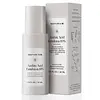What's inside
What's inside
 Key Ingredients
Key Ingredients

 Benefits
Benefits

 Concerns
Concerns

No concerns
 Ingredients Side-by-side
Ingredients Side-by-side

Water
Skin ConditioningAzelaic Acid
BufferingButylene Glycol
HumectantC12-15 Alkyl Benzoate
AntimicrobialGlycerin
HumectantCaprylic/Capric Triglyceride
MaskingMethylpropanediol
SolventPentylene Glycol
Skin ConditioningIsostearyl Alcohol
EmollientC13-15 Alkane
SolventEthylhexyl Olivate
Skin ConditioningButylene Glycol Cocoate
EmulsifyingNiacinamide
SmoothingAllantoin
Skin ConditioningSebacic Acid
BufferingAcetyl Rheum Rhaponticum Root Extract
BleachingAstrocaryum Murumuru Seed Butter
EmollientGossypium Herbaceum Seed Oil
Skin ConditioningBidens Pilosa Extract
HumectantLinum Usitatissimum Seed Oil
PerfumingAvena Sativa Kernel Extract
AbrasiveCarbomer
Emulsion StabilisingHydroxyacetophenone
AntioxidantSilica
AbrasiveBenzyl Alcohol
PerfumingPanthenyl Triacetate
Xanthan Gum
EmulsifyingSodium Hydroxide
BufferingEthylcellulose
Squalane
EmollientEthylhexylglycerin
Skin ConditioningLactobacillus Ferment
Skin ConditioningSodium Benzoate
MaskingPotassium Sorbate
PreservativeTocopherol
AntioxidantWater, Azelaic Acid, Butylene Glycol, C12-15 Alkyl Benzoate, Glycerin, Caprylic/Capric Triglyceride, Methylpropanediol, Pentylene Glycol, Isostearyl Alcohol, C13-15 Alkane, Ethylhexyl Olivate, Butylene Glycol Cocoate, Niacinamide, Allantoin, Sebacic Acid, Acetyl Rheum Rhaponticum Root Extract, Astrocaryum Murumuru Seed Butter, Gossypium Herbaceum Seed Oil, Bidens Pilosa Extract, Linum Usitatissimum Seed Oil, Avena Sativa Kernel Extract, Carbomer, Hydroxyacetophenone, Silica, Benzyl Alcohol, Panthenyl Triacetate, Xanthan Gum, Sodium Hydroxide, Ethylcellulose, Squalane, Ethylhexylglycerin, Lactobacillus Ferment, Sodium Benzoate, Potassium Sorbate, Tocopherol
 Reviews
Reviews

Ingredients Explained
These ingredients are found in both products.
Ingredients higher up in an ingredient list are typically present in a larger amount.
Allantoin is a soothing ingredient known for its protective and moisturizingg properties. Because of this, it is often added to products with strong active ingredients.
Studies show higher concentrations of this ingredient can promote wound healing.
Though it can be derived from the comfrey plant, allantoin is produced synthetically for cosmetic products to ensure purity.
Learn more about AllantoinEthylhexylglycerin (we can't pronounce this either) is commonly used as a preservative and skin softener. It is derived from glyceryl.
You might see Ethylhexylglycerin often paired with other preservatives such as phenoxyethanol. Ethylhexylglycerin has been found to increase the effectiveness of these other preservatives.
Glycerin is already naturally found in your skin. It helps moisturize and protect your skin.
A study from 2016 found glycerin to be more effective as a humectant than AHAs and hyaluronic acid.
As a humectant, it helps the skin stay hydrated by pulling moisture to your skin. The low molecular weight of glycerin allows it to pull moisture into the deeper layers of your skin.
Hydrated skin improves your skin barrier; Your skin barrier helps protect against irritants and bacteria.
Glycerin has also been found to have antimicrobial and antiviral properties. Due to these properties, glycerin is often used in wound and burn treatments.
In cosmetics, glycerin is usually derived from plants such as soybean or palm. However, it can also be sourced from animals, such as tallow or animal fat.
This ingredient is organic, colorless, odorless, and non-toxic.
Glycerin is the name for this ingredient in American English. British English uses Glycerol/Glycerine.
Learn more about GlycerinWater. It's the most common cosmetic ingredient of all. You'll usually see it at the top of ingredient lists, meaning that it makes up the largest part of the product.
So why is it so popular? Water most often acts as a solvent - this means that it helps dissolve other ingredients into the formulation.
You'll also recognize water as that liquid we all need to stay alive. If you see this, drink a glass of water. Stay hydrated!
Learn more about WaterXanthan gum is used as a stabilizer and thickener within cosmetic products. It helps give products a sticky, thick feeling - preventing them from being too runny.
On the technical side of things, xanthan gum is a polysaccharide - a combination consisting of multiple sugar molecules bonded together.
Xanthan gum is a pretty common and great ingredient. It is a natural, non-toxic, non-irritating ingredient that is also commonly used in food products.
Learn more about Xanthan Gum